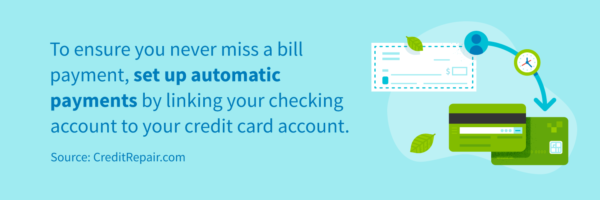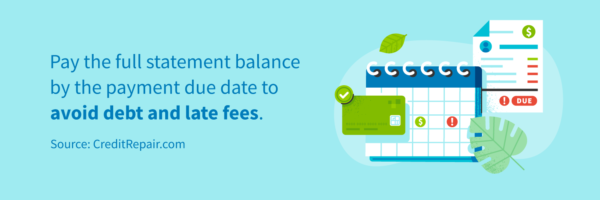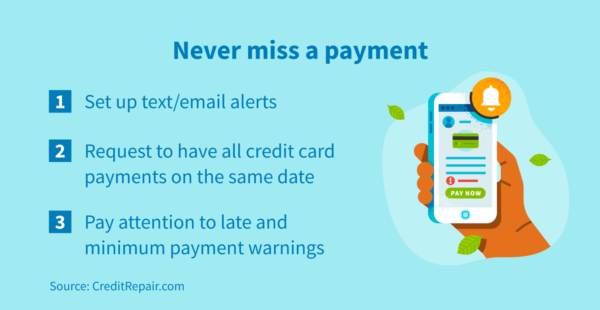
Disclosure regarding our editorial content standards.
When you get down to it, paying off your credit card bill is pretty straightforward: pay at least the minimum amount each month to be in the clear, and pay off the amount in full to avoid interest payments. Simple, right? Sure, but like many other financial topics, there are nuances to keep in mind.
It’s also important to understand how to pay your credit card bill to avoid interest fees and establish a positive credit history. There are lots of dates and amounts listed on credit card bills to keep track of. As a borrower, you have a responsibility to pay on time.
We’ll help you understand exactly how to pay off your credit card, but first, it’s essential to understand what’s on the statement you receive each month. Names or formatting will differ based on the issuer, but each statement will contain the same basics:
- Statement balance: This is the amount due for this statement period, and it’s sometimes called the new balance or outstanding balance.
- Minimum payment due: This is the lowest amount you can pay before the due date. It’s either a fixed amount or a percentage of the balance based on the credit card terms.
- Payment due date: If the minimum payment isn’t made by this listed date, you will be charged a late fee.
- Minimum payment warning: This shows you how long it would take you to pay off your current balance if you only made minimum payments. It also shows what the interest would look like.
- Account summary: This shows the overall details of how the current balance was calculated—it starts with the previous month’s balance, subtracts recent payments and credits and then adds purchases, interest charges and fees.
You’ll also see all the payments and credits you’ve made that will be factored into your current balance, new purchases made during the billing period, fees, interest charges and any additional rewards or perks with your given card. From there, you can decide how to pay.

There are various ways to pay down your credit card bill every month:
- Online bill pay: Most credit card lenders will allow you to link your checking account to complete your monthly payments.
- Money transfer: Some lenders will allow you to wire transfer money to pay your bill.
- Cash or check: You might be able to pay your credit card bill in person at a local bank or credit union branch, or you may be able to mail a check.
- ACH check: You’ll need to provide your credit card issuer with your bank’s account and routing numbers—you can do this online or over the phone.
Any of the above payment methods are completely viable options—it’s all about what your credit card issuer accepts and what works best for you. Once you decide on a payment method, stick to it: put a recurring reminder in your calendar, set up automatic payments or set up reminders on your mobile banking app. Next, you just need to decide when to pay your bill.
When to pay your credit card bill
This is an easy one, right? By the deadline! Aside from that obvious answer, you do have a little bit of leeway in terms of when you pay off your credit card bill.
First and foremost, we highly recommend that you pay the full statement by the payment due date. This is valuable for a few reasons: one, it has a positive impact on your credit, and two, it notifies lenders that you can borrow money responsibly. It’s important to allow time for your payment to process, and it can be helpful to pay a few days before the statement closing date for this reason (more on paying early later).
Credit card issuers differ when it comes to how long they take to post a payment to your account, which means that the time from you sending a payment to the time your account says “paid” can vary. It’s worth checking with your specific bank to verify what counts as an on-time payment and how long it takes for payments to be posted to your account.
For example, if you prefer to mail in a check, will your payment be considered on time if the letter is postmarked by the due date, or does the provider need to have the check in hand by the posted due date? These are the questions to ask before signing up for a specific card.
However, it’s not required that you pay the entire outstanding balance right away. Typically—but not always—credit cards have a grace period, which is the time between your billing cycle’s completion and your statement’s due date. During this period, you will not accrue interest on purchases made during the previous billing cycle. This is a great time for multiple payments, which we’ll cover below.
If you can’t afford to pay the full statement balance, we recommend at least paying the minimum payment by the same due date. This can help you keep a handle on your credit card debt and avoid any expensive late fees. Making minimum payments is a good option if you use a card with a zero percent intro APR (annual percentage rate) offer and take advantage of the zero percent interest and balance transfers. While you’ll still need to make the minimum payments each month to avoid late fees, you’ll have more time before the bank charges interest.
Paying your credit card bill early
Some overachievers like to pay off their accounts early before the statements are even generated, meaning that when the bank generates the statement, it will show a $0 balance. As long as you have a grace period, this will not save you any money on interest, so it’s not entirely necessary. However, if you’re aiming to improve your credit score, paying early can help lower your overall credit utilization, which is the ratio between your total credit card balance and total credit limit.
Carrying a balance on a credit card
Another common misconception is that carrying over a balance from month to month will help build credit, but this isn’t true. What helps to build credit is paying your bill on time. In fact, we recommend you avoid carrying over a monthly balance and instead try paying in full when possible to avoid hefty interest charges, even if your credit is already established.
Credit card fees
There are some fees to keep an eye on when paying off your credit card every month. It’s important to understand these before you sign up for a specific card.
Interest fees
If you make a minimum payment instead of paying off the full statement balance, you’ll be charged an interest fee, also called a finance charge. Credit card lenders assess interest charges based on your daily average balance. Interest applies to this daily average balance over the course of a billing period, and you’ll start incurring interest expenses daily once you start carrying a balance on your card. If you’re looking to build your credit, especially if you’re just getting started, avoiding interest is important.

Here’s one way to see if you can figure out how much interest you pay daily: divide your credit card’s APR by 365. It’s important to note that rates vary by the individual and by the credit card you use. Those with better credit scores will have lower interest rates. Check your card’s terms to make sure you understand how your interest is being calculated.
Most credit cards will allow you to set up online payments that automatically come out of your checking or savings account. This will help ensure that your payments are made on time or before the due date each month—a great way to help avoid late payments.
Late fees
You’re charged late fees when your payment is received after the due date or grace period (if you have one). If you have an outstanding balance on your card, you typically have a minimum of 21 days before that payment is due. If you fail to make this payment, you’ll be charged a late fee.
Some cards have tiered late fees based on your credit card balance while others are fixed, regardless of the balance on your card. By law, issuers can charge a $28 late fee the first time you’re late (or, if you’ve been late on a payment in the past six months, they can charge up to $39).
Like we said earlier, we recommend setting your automatic payments to come out a few days before the payment due date to allow time for processing. When setting up autopay, you’ll be able to select the date and also decide if you’d like to pay the minimum amount, a custom amount or the statement balance.
Tips for staying on top of credit card payments
Admittedly, it’s difficult to stay on top of credit card payments with all your other bills piling up. We’ve put together some tips that will help you avoid missing a payment or contracting a late fee:
- Set up alerts. You can easily set up text or email alerts that will notify you when your payment due date is coming up.
- Consolidate payment dates. If you have multiple cards, you can request the same payment date by simply calling your card issuers or making a request online. This will help eliminate having to remember multiple payment dates.
- Understand the terminology. Often, you’ll receive late payment or minimum payment warnings that will highlight the consequences of not making certain payments. By educating yourself on these concepts, you can better respond to these warnings.

While different credit cards have rewards and perks unique to them, the process of paying your bill ultimately remains the same. It may seem overwhelming at first, but if you commit to paying the full statement balance by the due date, this can help you establish a positive credit history and ensure that you avoid late fees and interest.






